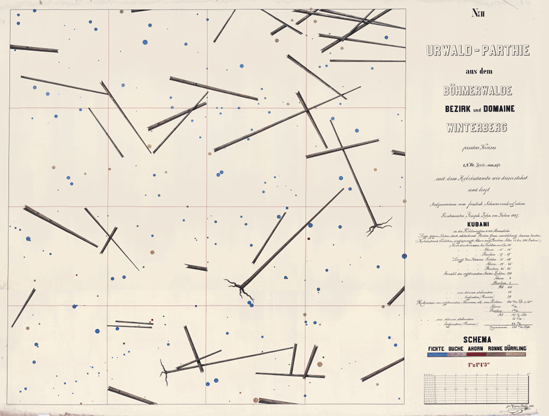Widespread wood cutting was typical for the first half of the 19th century Czech lands. It was associated with the development of metallurgy and other industrial production. Majority of forest regeneration area was replanted by artificially introduced Norway spruce (Picea abies). However, already first or second generations of spruce monocultures (namely poorly raised, unstable stands) experienced large windbreaks which were later accompanied by extensive calamities of bark beetle (Ips typographus). Rapid disappearing of yet untouched virgin forests in less accessible mountainous areas led to establishing first forest reserves on the European continent. In 1838, nature lover Earl Jiří Buquoy, Goethe’s friend, established a forest reserve, so called Žofín virgin forest, in forest district Obora which belonged to his Novohrad estate in South Bohemia. Not only tree felling but also litter raking and other human interventions in natural forest development were forbidden in this reserve.

Boubín virgin forest 1847 – map of John’s sample plot No.2
Ing. Josef John from Boubín in the Šumava mountains followed similar line of thinking. However, his interest in the existing virgin forests was not inspired only by romantic notions. He understood that these forests were a key to understand natural processes uncontrolled by man and that without this knowledge it is impossible to manage sustainable forestry and active protection of virgin forests.In 1843, Josef John became head of forest management of the former Schwarzenberg estate in Vimperk. Since1847 he planned to use observations about tree development in the virgin forest in the forestry science and he had probably considered their preservation for future generations (NOŽIČKA 1958).
Thanks to Josef John virgin forests from Šumava had become focus of Czech foresters already since 1849. On 2 September 1849, Czech Forestry Society organized first excursion with participation of many leading expert into Boubín virgin forest and thus enabled many participants to see a real virgin forest for the first time. According to the records, about 33 000 acres (19 992 ha) of virgin forests were present in the former Schwarzenberg estates (GÖPPERT 1868). Publishing report about this excursion aroused interest for Šumava virgin forests not only the Czech lands but also in the neighbouring countries.
In the summer of 1851 Josef John delimited 8 sample plots in the Boubín virgin forest. He tasked superintendent František Jungwirth to map them in order to capture their truest and most demonstrative image of the virgin forest, stratification of the trees and their sizes. Jungwirth mapped seven plots by October 1851 and sent them for inspection to Schwarzenberg in Třeboň. However, John requested their return on 9 April 1852 and stressed the need for his scientific needs. The maps were actually returned to John (NOŽIČKA 1958, 1959).
